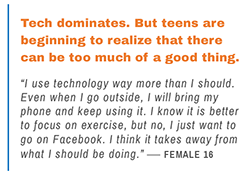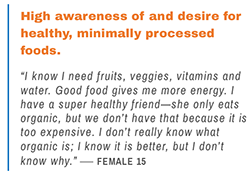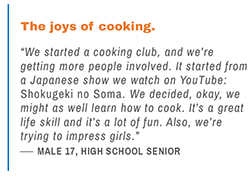Gen Z: Holding the Keys to Unlocking the Future Marketplace

Toss out the rules. Set aside well-worn beliefs. Make room for the new kids on the block. Millennials may be the prized target of the moment for marketers, but Gen Z is not so silently waiting in the wings, poised to make their own mark and blaze their own trail in contemporary lifestyles and food culture.
For some time now, we’ve been documenting the transformation of food culture and how the macro factors have combined to create a modern food culture that is marked by fragmentation — a blurring of boundaries, an upending of rituals and the deconstruction of formerly idealized traditions. Gen Z is growing up and coming of age in this era of disruption and upending of tradition. They have the keys to changing their lives and getting to a better place.
Already at about a quarter of the U.S. population, Gen Z is projected to eclipse Millennials in size. Yet sheer size alone is not the only determinant that distinguishes Gen Z from other generations. While there are already many predictions out there as to how this youngest generation of the U.S. will act, the reality is no one can know for sure at this point. What we do know is that just as stereotypes have not been an accurate portrayal of the real Millennial generation of consumers — especially as reflected by their eating and drinking attitudes and behaviors — typecasting Gen Z at this early stage would be an equally futile exercise.
Here are five ways that distinguish Gen Z from other generations. They provide a glimpse into how this soon-to-be-influential generation will shape culture and the food and beverage marketplace going forward.
Growing up digital: almost no separation between online and real life.
Gen Z are digital natives who have never known a time without the internet. Technology is central to every aspect of their lives, from socializing to schoolwork, entertainment to exercise, relaxation to reference. According to Pew Research Center, 25 percent are online “all the time.” Some reports show that they are getting more online time than sleep time! The Pew Research Center “Teens, Social Media & Technology Overview 2015, Ages 13-17” found that Gen Z send and receive over 67 texts on average every day.

With so much knowledge at their fingertips, there is no excuse not to know something. This power allows them to fact-check instantaneously when they question something. Teens turn to their online social communities for advice and information. Tech is fun, tech is entertaining, tech is useful. Tech enables teens to:
- learn about foods and beverages
- learn “how to…” or exercise (apps, YouTube)
- socialize (Snapchat, Facebook, Instagram, imgur)
- explore finding new music (YouTube, streaming services)
Ethnic diversity will shape their outlook.
Alongside being fully integrated in technology, let’s not forget that Gen Z is the most ethnically diverse age group yet. Their diversity will continue to drive food culture trends we already see around the exploration of authentic, global food experiences. Impacts of this diversity will likely include: how they eat (more exposure to global/regional foods); how they communicate (more opportunity to be multilingual with parents from different ethnicities); how they get along with others (greater opportunity for acceptance); how they shop (everything is within the “norm”); how they see the world (fewer boundaries, moving away from an “us” vs “them”).
Influencing grocery shopping but not into the in-store shopping experience.
Teens influence their household’s grocery shopping, but often without necessarily making direct requests or going to the store. Most teens rely on their parents for grocery shopping; parents typically know what their kids like and cater to their needs. Many teens avoid going shopping with their parents if they can, viewing it as a boring chore. Gen Z’s influence on grocery shopping and purchase decisions will have very interesting implications for the future of food buying. Their interest in short trips means Gen Z may follow in Millennials’ footsteps by:
- making shorter shopping trips, more frequently
- having smaller basket sizes
- using online grocery shopping/pick-up
- using apps and technology to investigate products and speed up grocery shopping
Health and wellness outlook: already well schooled in fresh, less processed.
 Despite lower involvement with grocery shopping, Gen Z teens still show relatively high awareness of and desire for healthy, minimally processed foods. Their lack of shopping experience means that Gen Z’s high level of health and wellness awareness does not necessarily translate to sophisticated knowledge. With similar patterns overall to adults, however, Gen Z is clearly aware of current health and wellness trends. Taught in school how to read nutrition labels, teens know the basics of a healthy diet, and they are learning all about fresh, less processed from their parents. Expect Gen Z’s frequency of adding and avoiding ingredients to grow as they become more independent and informed.
Despite lower involvement with grocery shopping, Gen Z teens still show relatively high awareness of and desire for healthy, minimally processed foods. Their lack of shopping experience means that Gen Z’s high level of health and wellness awareness does not necessarily translate to sophisticated knowledge. With similar patterns overall to adults, however, Gen Z is clearly aware of current health and wellness trends. Taught in school how to read nutrition labels, teens know the basics of a healthy diet, and they are learning all about fresh, less processed from their parents. Expect Gen Z’s frequency of adding and avoiding ingredients to grow as they become more independent and informed.
Cooking habits: for Gen Z, it’s a fun hobby.
Gen Z is the first generation to completely grow up in the digital age, so to them there is no question that can go unanswered. This has a major influence on the foods and beverages they consume because they want to know where it’s from, how it's grown/made and who made it. Thus, Gen Z approaches cooking differently than older generations. Rather than recipes and instructions, for example, Gen Z teens may prepare a dish based on wordless pictures posted online. In the future, Gen Z might be much more intuitive cooks because they won’t rely on written recipes the way past generations have in the U.S.
For more in-depth insights into Gen Z and Millennials:
FOODWAYS OF THE YOUNGER GENERATIONS: MILLENNIALS AND GEN Z 2016 REPORT
SPECIAL REPORT: GEN Z HEALTH & WELLNESS 2015 SPECIAL REPORT
